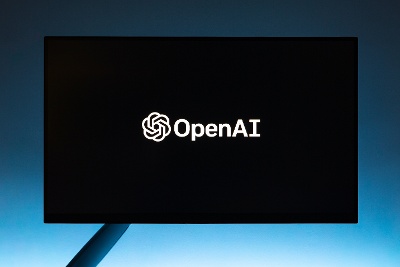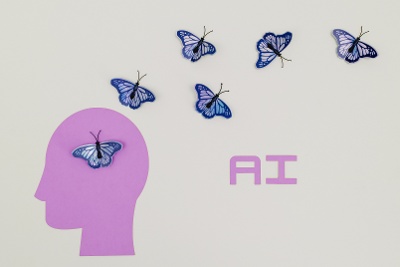How Daemon can help businesses become more efficient by using AI
Everyone is talking about AI. A range of AI-driven tools like ChatGPT, Midjourney and Copilot have taken the world by storm, with ChatGPT setting a new record for the fastest growing user base of all time. This explosion in AI is not just in users, but also in use cases, meaning millions of people now have access to a range of high-quality AI tools.

While this technology is nothing new, the speed of its development has surprised even experienced researchers in the field working with the core technologies. This has caused both excitement and concern, with experts predicting everything from a work-free utopia to the end of humanity itself.
With so much chatter around, it can be hard to look at the issue objectively. Many businesses have a sense that they should be embracing AI, but don’t know where to begin. This is where we can help.
In this article, our Principal Machine Learning Consultant Greg Duckworth (GD) and our Senior Machine Learning Consultant Damien Duff (DD) share more about Daemon's tried and tested approach and how we can help you harness this new technology in the most effective way possible.
How are clients using AI?
DD- Most of our clients fall into one of three groups. The first group realises that AI is a vital tool for the future, but doesn’t know how to incorporate it into their business. The second has some idea of how they want to use AI, but are struggling to get their project off the ground. Finally, there are those who have already built an AI solution but are struggling with faults, visibility and time to market.
Have clients' expectations changed as AI has become more mainstream?
GD- Clients definitely have a greater awareness of the capabilities of AI. In the past, it was mainly seen as a way to increase efficiency by automating low-level tasks. This is still a big part of its appeal, but customers now expect a wider range of functions.
DD- A recent proliferation in AI tools based on generative AI that can be used by anyone - like Copilot, Midjourney and ChatGPT - have shown that AI can be used for a massive range of creative tasks, and this has caused many to see the technology in a new light. This has coincided with rapid progress in other areas, such as computer vision, insight generation, fraud detection and personalisation. Clients are constantly hearing about these new applications, and they don’t want to miss out.

How do you decide on the best solution for the client?
DD- First of all, remembering that some clients, while understanding that AI is the future and that they ought to get a handle on it do not necessarily know how AI can be of help to them at all, it can be less a case of deciding on the best solution for a problem, and more of a case of finding the part of the business that can be impacted most by AI - where to dig for gold. If we have already identified the business problem to solve, before we can settle on a solution, we still need to make sure we understand the business problem in question - this might even involve reframing the problem entirely. This is where our Ignite workshop comes in. This is a minimum half-day session with the ultimate goal of settling on and aligning the whole team around a proposed solution. Besides the standard workshop fare- facilitation, icebreakers, setting clear outcomes- an Ignite session has two unique steps.
Firstly it's all about getting an overview of the challenges the customer is facing. Once we’ve agreed on the problem, we bring in our technology experts to suggest solutions.
Although the workshop is focused on AI, an AI solution is not always the best solution. We offer everything from cloud services to digital engineering, and any of these could be the answer to the client’s problem - or none of them: we always endeavour to be a client- centred and people-first consultancy, so our guiding principle is simply finding the best approach. Rather than arriving with a readymade solution, we get to know the business and then create a solution to match. This is what we mean by design thinking.
Once we’ve settled on a solution, we begin phase two. We perform a thorough effort/impact analysis, identifying and fully exploiting the best possible use case. This analysis is the real value of the workshop. By the time we’ve finished, our customers will understand exactly how AI can be used to solve their problem. From here, we can work together to create a more detailed plan of action.
Read more about our unique approach to designing IT solutions
-1.jpg?width=400&height=267&name=pexels-fauxels-3183197%20(1)-1.jpg)
.
Once you’ve agreed on a solution, how do you prepare to implement it?
DD- One of the main kinds of AI we use is machine learning, and this is an entirely data-driven field. The quality of our data directly affects the quality of the finished product, so we spend a lot of time ensuring that this data is as good as possible. We want to make sure that we understand the data we have, and that we aren’t missing any data we need.
As well as focusing on data, we take great care to understand the needs of the business and its stakeholders. We dig down into the processes and needs at the heart of the proposed solution to ensure that value is being delivered at every stage. We also map out all the stakeholders and consult them whenever our analysis changes. This allows us to include only the highest value features in our first prototype.
What are the advantages of building a prototype at such an early stage?
DD- Quick and constant feedback is a key part of the “agile” development process. Although we don’t follow this framework religiously, it has a lot to offer when developing AI/ML solutions. By adapting as we go, we reduce the risk of pouring money into a big project only for it to fail.
Building an early prototype is an important part of this process. It provides an avenue for regular feedback. The client has something to test, and we have something to adapt based on their reactions. Through frequent demonstrations and regular reporting, we are able to test our previous assumptions and ensure that we only incorporate the features that really work.
It can be worthwhile to point out that when designing the prototype we need to build in ways of measuring its value - that could be in terms of accuracy, or direct impact on business KPIs like customer conversion. This makes the prototype into a "proof of value" - you use it to really assess the benefits and cons of the proposed approach.
Tell us about the production phase. What are the most common challenges?
GD- Turning an idea into a practical solution is always a difficult process. According to McKinsey, 88% of data science projects don’t make it into production, but we’re pleased to say our record is a lot better! This is because we take the time to predict and deal with the most likely hurdles at an early stage. By the time we go into production, there’s not much left that can surprise us!
DD- Every project is different, but we’re faced with the same challenges time and again. We might need to integrate the solution with a range of systems without disrupting day to day work. Or maybe we’ll have to integrate it with a number of different customer flows. Whatever is needed, we won’t leave until it’s done.
There are also cultural challenges to overcome. It’s important to lay the groundwork for ongoing success, and this means making sure that we’ve shared all the necessary knowledge to keep things running smoothly after we’ve gone. This could mean teaching your engineers to maintain the new system, or agreeing to provide ongoing support ourselves.
These problems are common to all projects, but AI also creates its own unique challenges. Because we are harnessing data from the wild, we need to be absolutely sure of its quality. Additionally, we need AI specific frameworks that encapsulate best practice in iterative development - sometimes even experimentation - in what are essentially heuristic systems, to ensure that the AI will operate in a safe, unbiased and efficient way.
Read more: How Daemon empowers teams to deal with their own IT problems
What does the finished product typically look like?
DD- It’s hard to say because every project is unique. It could be anything from a recommendation system incorporated into a website, to a forecasting and optimisation system linked to a company’s warehouse. Whatever it looks like, every finished product has one thing in common. It will be tailored to the problem we’ve identified, and will have been honed to perfection through many rounds of feedback.
What sets Daemon apart from the competition in this area?
DD- We’ve been helping teams to build digital solutions since 2007, and we’ve learned plenty along the way. We have a history of excellence across all areas of digital transformation, with a proven track record of solving problems and providing robust products.
A big part of our success is our one team approach. Unlike many of our competitors, we embed ourselves in the teams we are helping. There’s no throwing solutions over the wall. We want to merge our team with yours in order to create a solution that works for everyone.
How we energise movements in teams
This approach has worked its magic with everyone from small start-ups to huge global brands, and we’re confident that it can be adapted to any situation. Although AI/ML is a newer area, everything we’ve learned since 2007 is brought to bear on each project.
Find your place in the future
There’s no doubt that AI will fundamentally reshape the way we do business. This kind of change can be scary, but there’s no need to go it alone. If you have any questions about AI, ML or any other aspect of digital transformation, don’t hesitate to get in touch.

